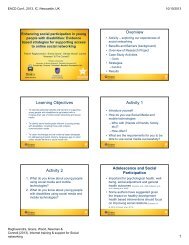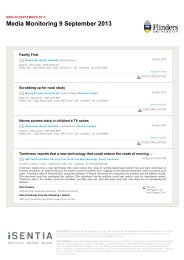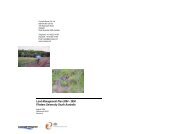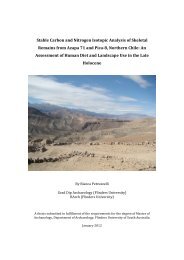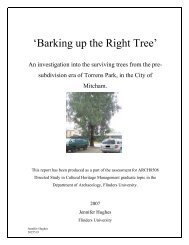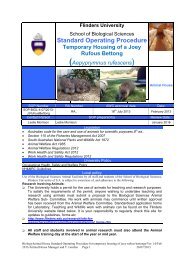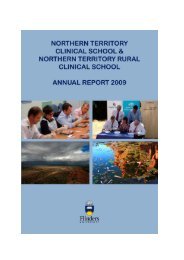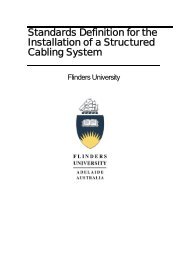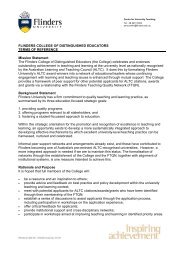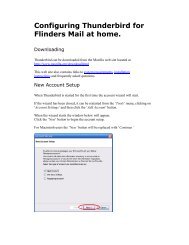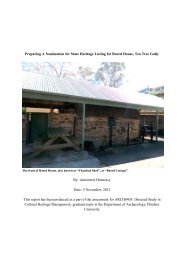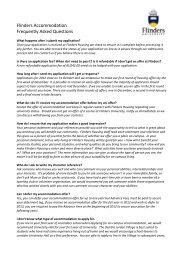Standard Operating Procedure For Lizards - Flinders University
Standard Operating Procedure For Lizards - Flinders University
Standard Operating Procedure For Lizards - Flinders University
You also want an ePaper? Increase the reach of your titles
YUMPU automatically turns print PDFs into web optimized ePapers that Google loves.
Admission into the <strong>Flinders</strong> <strong>University</strong> School of Biology Animal Care Unit:<br />
<br />
<br />
Where animals are transported to <strong>Flinders</strong> <strong>University</strong> School of Biology Animal<br />
Care Unit, they must be placed into prepared cages in a temperature-controlled<br />
room and provided with ONLY water upon arrival. Animals must not be offered<br />
food until they have acclimatized for at least 24 hours.<br />
Animal House staff must be notified in advance of expected arrival day and time.<br />
Space booking and housing with appropriate environmental parameters must be<br />
confirmed prior to transport commencing<br />
The animal house staff will have allocated space to quarantine the animals for 2<br />
weeks so they must not come into contact with other animals housed at the<br />
uni. This will help reduce the transfer of disease. Quarantined animals should<br />
have their separate nets, water bottles and cleaning equipment allocated.<br />
Release:<br />
<br />
<br />
Once lizards have been held captive at the <strong>Flinders</strong> <strong>University</strong> School of Biology<br />
Animal Care Unit they are NOT routinely released back into the wild. However,<br />
<strong>Flinders</strong> <strong>University</strong> does have permission to release a limited number of specific<br />
species.<br />
<strong>Lizards</strong>/snakes that have been captured at remote sites and transported to a<br />
“sterile” holding area may be routinely released back into the wild.<br />
Notwithstanding this, the release must follow the AWC Approved Project protocol<br />
and transport to the release location must adhere to this <strong>Standard</strong> <strong>Operating</strong><br />
<strong>Procedure</strong>.Where lizards/snakes have been provided supplemental heat to raise<br />
the temperature to between 25˚C and 30˚C and the maximum forecast<br />
temperature is anticipated to fall between 20˚C and 25˚C, the lizards will need to<br />
be acclimatized to the lower temperatures for a week prior to release.<br />
Quarantine/ Health Monitoring<br />
• All animals should be assessed by experienced staff and confirmed as<br />
healthy prior to transport to the Animal House. A visual examination is<br />
sufficient- examination should be consistent with parameters on animal<br />
monitoring records and lizard assessment checklist.<br />
• <strong>Lizards</strong> should be quarantined individually or in preestablished pairs/ social<br />
groups (eg they were housed together at the facility they have come from or<br />
were observed to be part of a pair/social group in the wild)<br />
• <strong>Lizards</strong> may be quarantined in their individual tank in any of the designated<br />
lizard rooms<br />
• During Quarantine reptiles should be weighed and photographed for individual<br />
identification.If they are permanently being housed either individually or in a<br />
pair where each individual can be clearly identified visually, tank number is<br />
sufficient identification. Records will be created for individual reptiles to<br />
maintain this information and ongoing health monitoring<br />
• During quarantined reptiles will be acclimatised to their preferred temperature<br />
range and standard diet.<br />
BiologyAnimal House <strong>Standard</strong> <strong>Operating</strong> <strong>Procedure</strong> for working with <strong>Lizards</strong>/Ver 1.0/Sept 2009/Animal<br />
House Manager Page 6 21/06/2013



